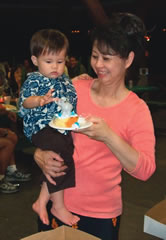Celebrating The Luau Tradition

Wednesday - August 01, 2007
|
 Del.icio.us
Del.icio.us

|
You don’t have to give me a good reason to sit down to a buffet of tasty Hawaiian food anyway, but the recent first birthday of my fiance’s nephew, Lucas, was certainly reason enough to celebrate!
The first birthday baby luau is a popular time to celebrate in Hawaii, as are occasions such as graduations, weddings or other major life events.
Lucas’ baby luau utilized the helping hands of several family members, who erected tents, cooked food and decorated the event site so that even more family members and friends could come and celebrate the first year of life for this beautiful baby boy.
In this modern-day luau, everyone talked and ate the prepared food, enjoyed each other’s company as well as the music being piped through an iPod stashed in the corner of the room. Plenty of soda and sweets gave the keiki energy to play all night, and the rain from Tropical Depression Cosme stayed at bay at least for a few hours so we
could enjoy the outdoor setup.
This occasion, (one of the few baby luaus I’ve been to so far since my friends are only just starting to have babies) made me
curious about some of the history of the luau.
It turns out in ancient times, Hawaiians held feasts to mark special occasions such as to celebrate the birth of a child, a successful harvest or a victorious battle. These feasts honored the gods who had shown the people great favor. The celebrations were called ‘aha ‘aina (“gathering for a feast”) - the term “luau” (the tender leaves of the taro plant used in cooking) actually came about much later.
In ancient Hawaii, men and women ate their meals separately. Commoners and women
of all ranks were also forbidden by the ancient Hawaiian religion to eat certain delicacies.
All this changed in 1819, however, when King Kamehameha II abolished the traditional religious practices, throwing a feast where he ate with women - a symbolic act that ended old taboos and gave birth to the luau of today.
A traditional luau feast was eaten on the floor. Lauhala mats were rolled out and decorations made of ti leaves, ferns and native flowers adorned the center. These decorations stretched more than three feet long, leaving room for bowls of poi, platters of meat, sweet potatoes and dried fish to be laid directly on the ti leaves. Food was eaten with the utensils given to us at birth - our fingers.
In addition to the immense quantities of food, live music and hula dancing were also big parts of the celebration.
The royal luaus were, of course, the biggest. According to one source, one of the largest luaus ever hosted was by
Kamehameha III in 1847. The list of foods prepared included 271 hogs, 482 large calabashes of poi, 3,125 salted fish, 1,820 fresh fish, 2,245 coconuts, 4,000 taro plants and other delicacies.
At Lucas’ birthday luau we didn’t have quite that much food, though the dessert table was overflowing with all kinds of tempting treats generously prepared by partygoers. Luckily, utensils were allowed, though a few babies still chose to eat with their hands in the tradition of old Hawaii.
You could choose to have a regular birthday party to celebrate the momentous occasions in your life, but the luau is something unique. It keeps alive the traditions of an ancient time (however modern the preparations have become) and gives us cause to remember why the luau is not just a tourist attraction for visiting guests; it’s a part of what makes growing up in the Islands so very special.
E-mail this story | Print this page | Comments (0) | Archive | RSS Comments (0) |
Most Recent Comment(s):













